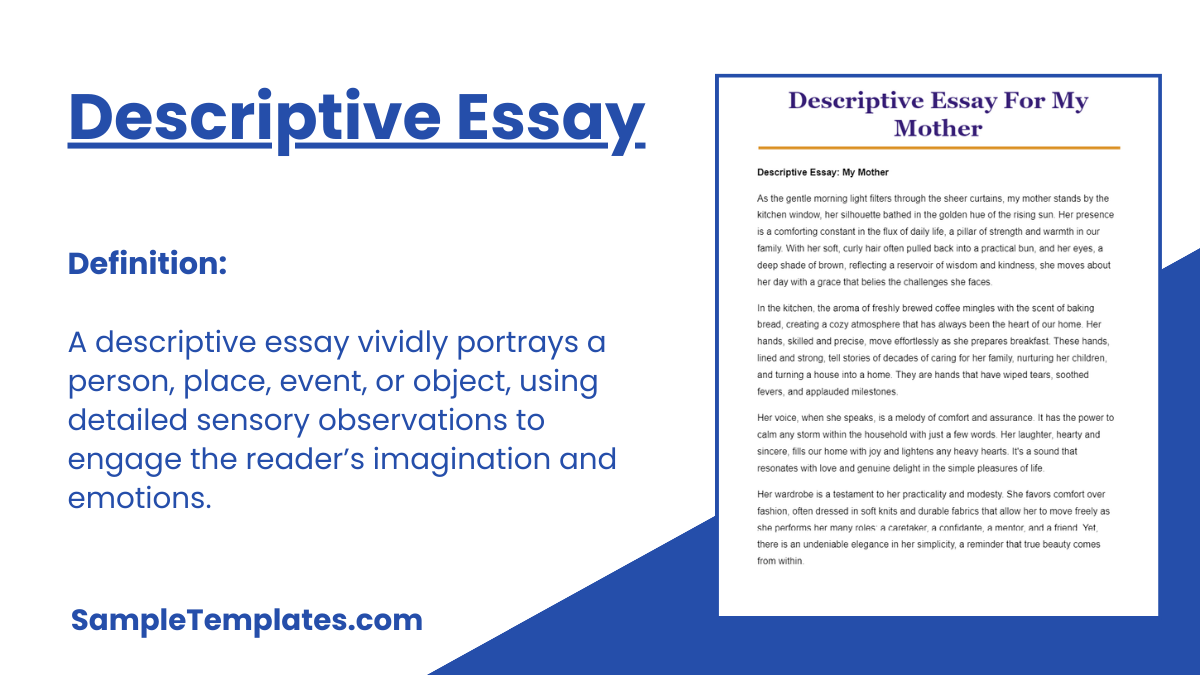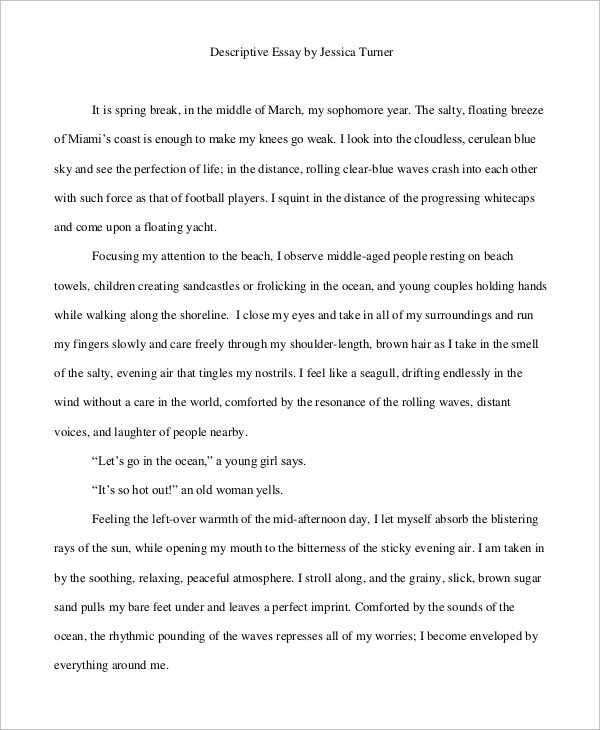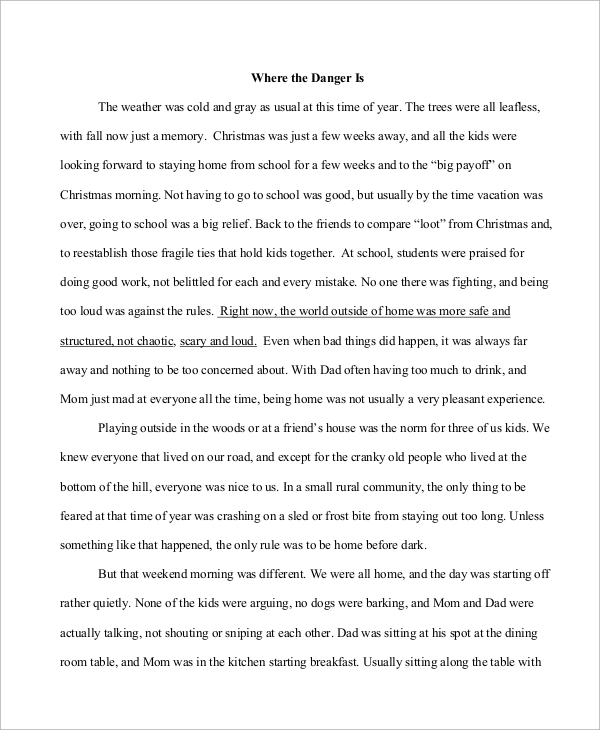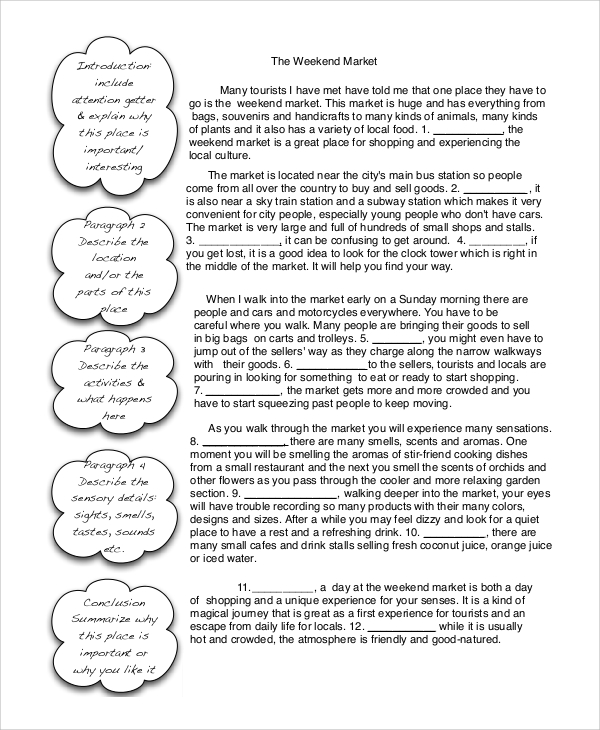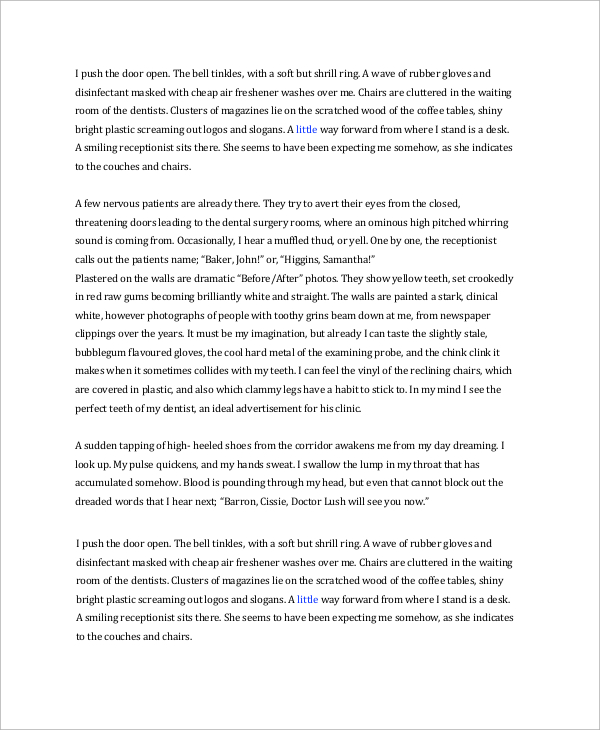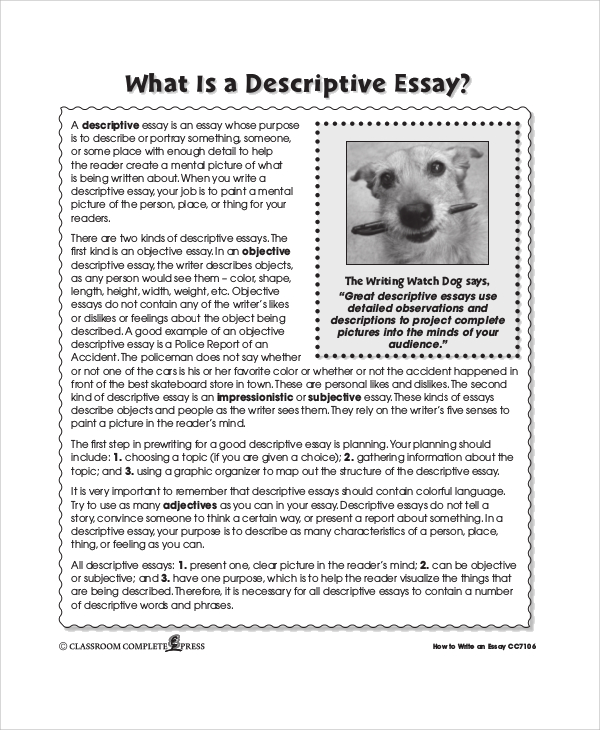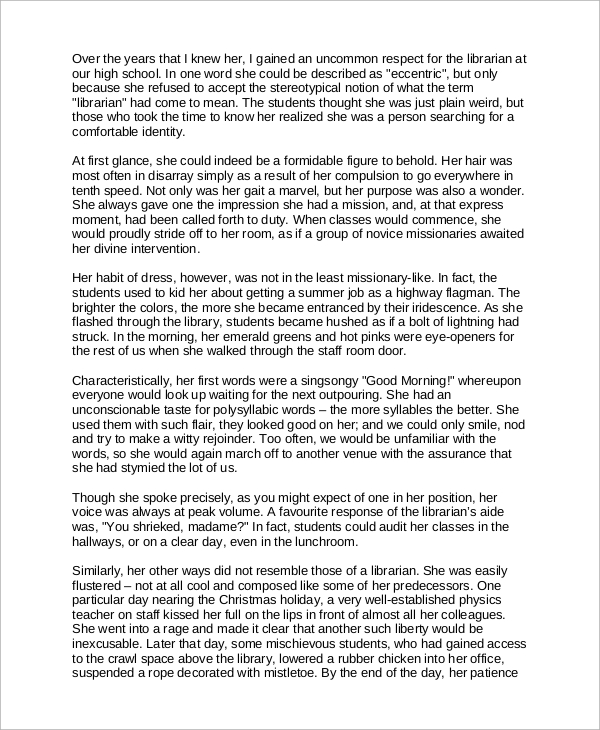In order to describe something or a place or a person one should write commonly used Descriptive Essay Examples. These essay samples can express emotion, sound or even an emotion. It is a method of writing about something so that the reader can himself feel, hear or see whatever the writer meant. It uses an explanation of sensory observations schedule in order to express an object, unlike narrative essays which reveal an object through personal stories. The writer should be able to bring an emotional connection between the reader and the subject.
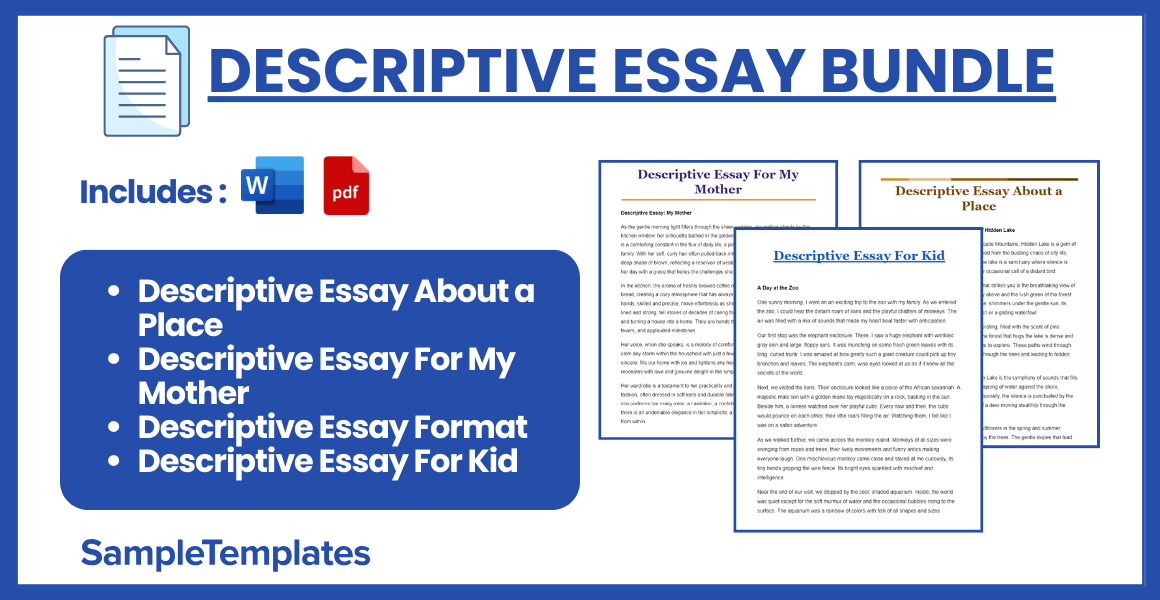
Download Descriptive Essay Bundle
Descriptive Essay About a Place
A Quiet Haven: Exploring the Tranquility of Hidden Lake
Nestled among the towering peaks of the Cascade Mountains, Hidden Lake is a gem of pristine beauty, an untouched haven far removed from the bustling chaos of city life. Surrounded by dense forests of pine and fir, the lake is a sanctuary where silence is only broken by the whisper of the wind and the occasional call of a distant bird.
As you approach Hidden Lake, the first thing that strikes you is the breathtaking view of its crystal-clear waters, mirroring the azure sky above and the lush green of the forest around. The lake, shaped like an artist’s palette, shimmers under the gentle sun, its surface occasionally disturbed by a jumping fish or a gliding waterfoul.
The air around Hidden Lake is crisp and invigorating, filled with the scent of pine needles and the earthy aroma of damp soil. The forest that hugs the lake is dense and verdant, with trails that beckon the adventurous to explore. These paths wind through the underbrush, offering glimpses of the lake through the trees and leading to hidden coves and quiet picnic spots.
One of the most enchanting features of Hidden Lake is the symphony of sounds that fills the air. The rustling of leaves blends with the lapping of water against the shore, creating a melody that soothes the soul. Occasionally, the silence is punctuated by the sharp cry of an eagle overhead or the rustle of a deer moving stealthily through the undergrowth.
The shores of Hidden Lake are dotted with wildflowers in the spring and summer, splashes of color against the green tape cast by the trees. The gentle slopes that lead down to the water are carpeted with soft grass, making it an ideal spot for a lakeside nap or a quiet afternoon with a book.
As the day turns to evening, the lake undergoes a transformation. The setting sun casts a golden glow on the water, turning it from clear blue to a deep, burnished amber. Shadows lengthen, and the forest seems to lean closer, as if to guard the lake’s secrets until the morning light.
Hidden Lake is more than just a place of beauty; it is a retreat for the soul, a spot where one can disconnect from the pressures of the modern world and reconnect with nature. Each visit leaves an imprint on the heart, a quiet reminder of the tranquility that can still be found in the wild places of the world.
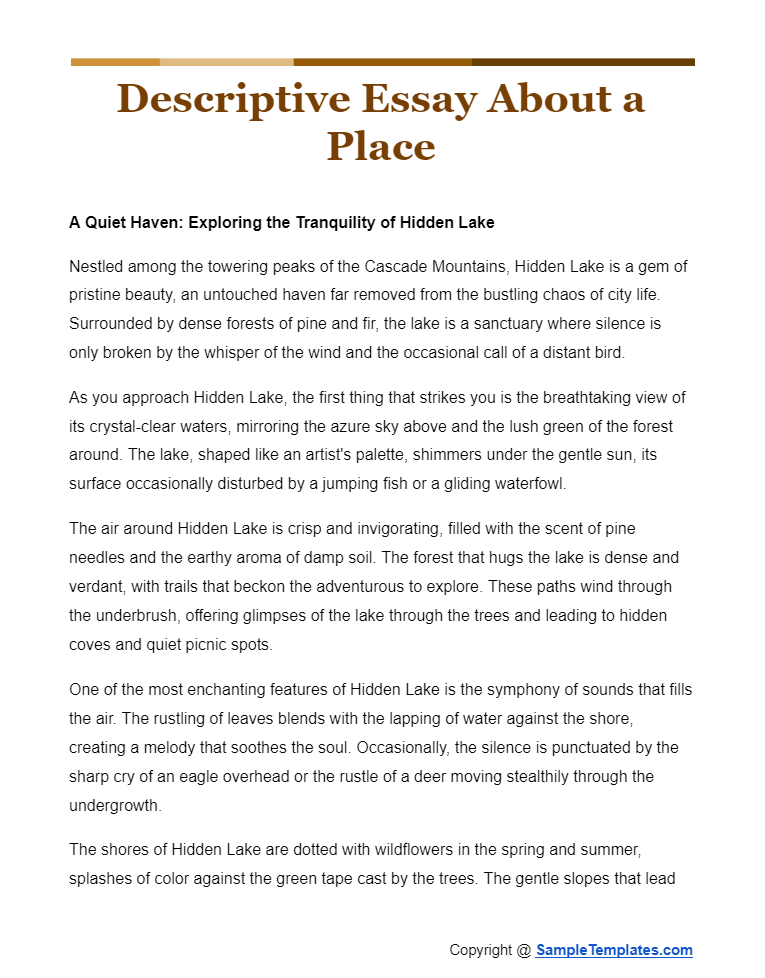
Descriptive Essay For my Mother
Descriptive Essay: My Mother
As the gentle morning light filters through the sheer curtains, my mother stands by the kitchen window, her silhouette bathed in the golden hue of the rising sun. Her presence is a comforting constant in the flux of daily life, a pillar of strength and warmth in our family. With her soft, curly hair often pulled back into a practical bun, and her eyes, a deep shade of brown, reflecting a reservoir of wisdom and kindness, she moves about her day with a grace that belies the challenges she faces.
In the kitchen, the aroma of freshly brewed coffee mingles with the scent of baking bread, creating a cozy atmosphere that has always been the heart of our home. Her hands, skilled and precise, move effortlessly as she prepares breakfast. These hands, lined and strong, tell stories of decades of caring for her family, nurturing her children, and turning a house into a home. They are hands that have wiped tears, soothed fevers, and applauded milestones.
Her voice, when she speaks, is a melody of comfort and assurance. It has the power to calm any storm within the household with just a few words. Her laughter, hearty and sincere, fills our home with joy and lightens any heavy hearts. It’s a sound that resonates with love and genuine delight in the simple pleasures of life.
Her wardrobe is a testament to her practicality and modesty. She favors comfort over fashion, often dressed in soft knits and durable fabrics that allow her to move freely as she performs her many roles: a caretaker, a confidante, a mentor, and a friend. Yet, there is an undeniable elegance in her simplicity, a reminder that true beauty comes from within.
My mother is not only the heart of our home but also the guide of my moral compass. Her values and ethics, steeped in love and respect for others, are imparted not through stern lectures but through her daily actions—her respect for others, her generosity, and her unflagging honesty. She teaches by example, showing me the importance of kindness, hard work, and dedication in everything one does.
Outside, in her garden, she tends to the flowers with the same care and attention she gives to her children. Each petal and leaf seems to bloom under her nurturing touch, mirroring the way she has helped her children grow and flourish. Her love for gardening reflects her belief in growth and renewal, values she instills in her family.
To the world, she may be just another woman, but to me, she is my mother—a remarkable person whose influence shapes my life daily. Her strength, kindness, and wisdom are qualities I aspire to embody. In every hug, every meal she prepares, and every moment she dedicates to her family, she weaves a tapestry of love and security that blankets us all.
As I watch her now, interacting with the family or lost in a book by the window, I am filled with gratitude and love. She is my mother, my mentor, my hero. A beacon of love and light in my life, her influence is immeasurable, her presence a gift I cherish every day.
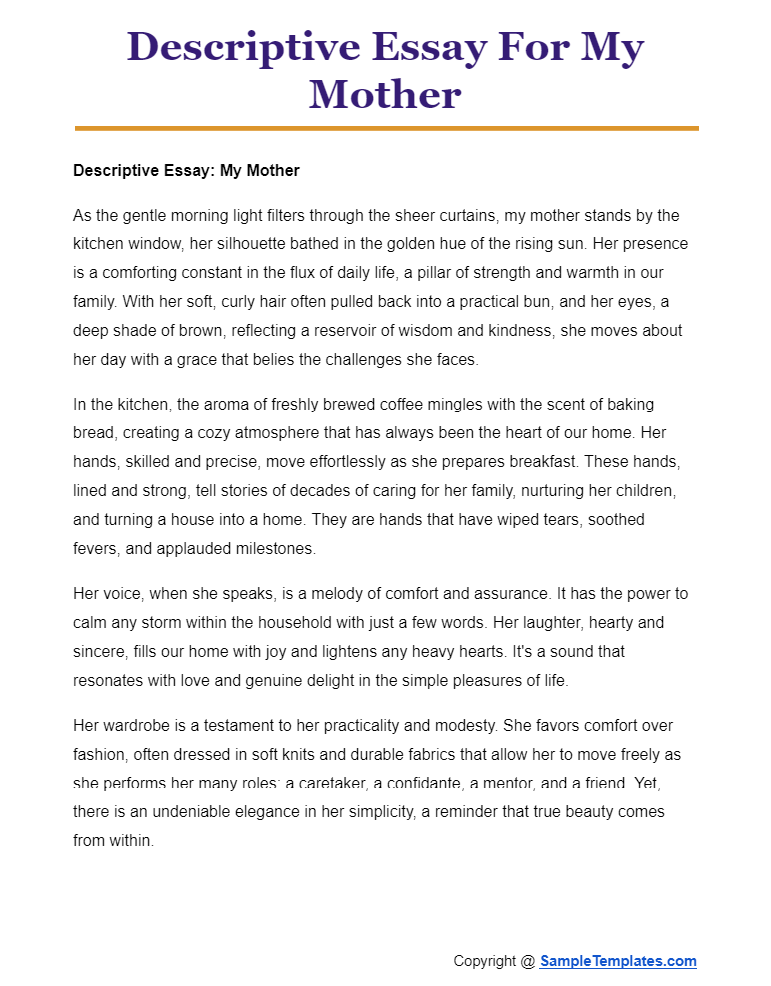
Descriptive Essay Format
A descriptive essay is a genre of essay writing that delves into the detailed depiction of a specific subject. The purpose of a descriptive essay is to provide a vivid and thorough presentation of a person, place, object, or event, so that the reader feels they can almost see, hear, or touch the subject being described. Here’s a breakdown of the typical format for a descriptive essay:
1. Introduction
- Hook: Start with a compelling opening sentence to grab the reader’s attention. This could be a striking fact, a question, or an interesting anecdote related to the topic.
- Context: Provide background information necessary to understand the subject of the essay.
- Thesis Statement: End the introduction with a clear thesis statement that outlines the focus of your description, emphasizing the unique qualities or significance of the subject.
2. Body Paragraphs
- Paragraph Organization: Organize body paragraphs by different aspects or sensory details of the subject. Typically, a descriptive essay will include 2-5 paragraphs in the body.
- First Paragraph: Focus on the most striking feature or the primary sensory detail (e.g., visual elements).
- Second Paragraph: Cover other sensory details such as sound, smell, or touch, depending on the subject.
- Subsequent Paragraphs: Delve into less immediate aspects, such as background history, emotional reactions, or related secondary experiences.
- Sensory Details: Use vivid and precise adjectives and adverbs to bring your descriptions to life. Engage all five senses to give the reader a complete sense of the subject.
- Comparisons: Use similes and metaphors to draw comparisons that can make the descriptions more vivid and understandable.
- Transition Sentences: Ensure each paragraph flows smoothly into the next with transition sentences that weave the pieces of your description together.
3. Conclusion
- Summary: Recap the main points discussed in the body paragraphs without simply repeating the details.
- Significance: Emphasize the significance of the subject and its impact on you or its relevance to a broader context.
- Closing Thought: End with a final thought or reflection that leaves a lasting impression on the reader.
Tips for Writing
- Show, Don’t Tell: Aim to show the reader what you are describing through imagery and sensory details, rather than just telling them.
- Focus on Details: Sometimes, the smallest details can make the biggest impression. Focus on nuances that are unique to the subject.
- Maintain Clear Structure: While the descriptive essay thrives on detail, maintaining a clear organizational structure is crucial to avoid overwhelming the reader.
A descriptive essay should not just relay facts but should transport the reader into the experience being described. Through careful word choice and thoughtful consideration of details, the essay becomes an evocative and engaging piece of writing that captures the essence of its subject.
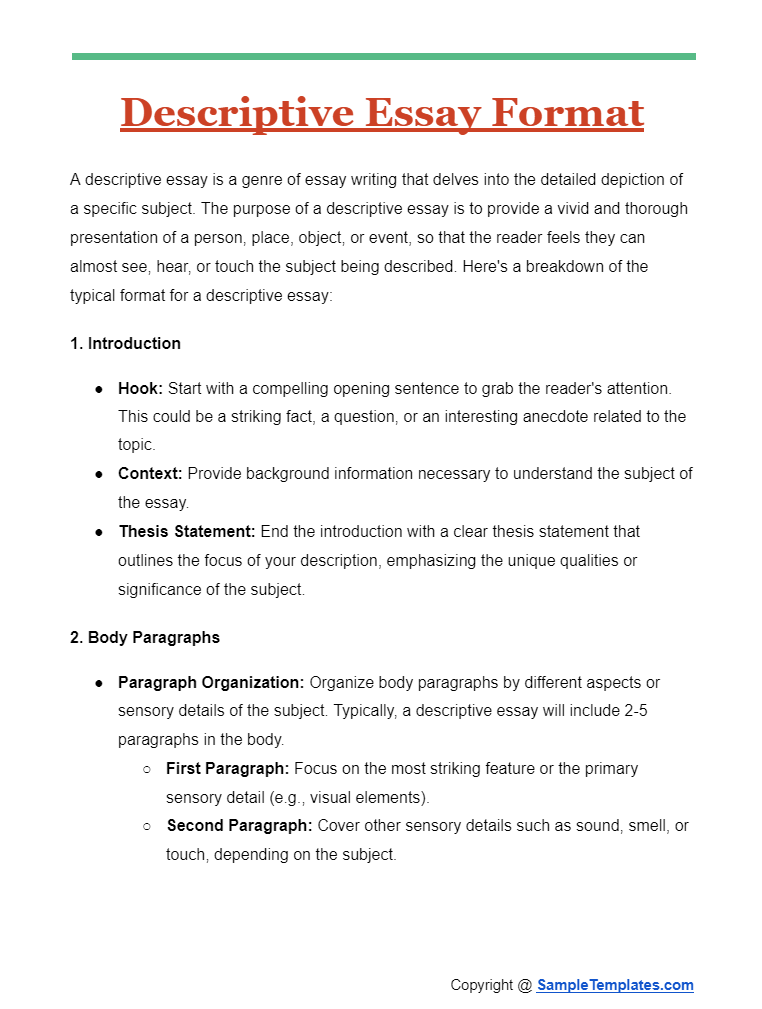
Descriptive Essay For Kid
A Day at the Zoo
One sunny morning, I went on an exciting trip to the zoo with my family. As we entered the zoo, I could hear the distant roars of lions and the playful chatters of monkeys. The air was filled with a mix of sounds that made my heart beat faster with anticipation.
Our first stop was the elephant enclosure. There, I saw a huge elephant with wrinkled gray skin and large, floppy ears. It was munching on some fresh green leaves with its long, curled trunk. I was amazed at how gently such a giant creature could pick up tiny branches and leaves. The elephant’s calm, wise eyes looked at us as if it knew all the secrets of the world.
Next, we visited the lions. Their enclosure looked like a piece of the African savannah. A majestic male lion with a golden mane lay majestically on a rock, basking in the sun. Beside him, a lioness watched over her playful cubs. Every now and then, the cubs would pounce on each other, their little roars filling the air. Watching them, I felt like I was on a safari adventure.
As we walked further, we came across the monkey island. Monkeys of all sizes were swinging from ropes and trees, their lively movements and funny antics making everyone laugh. One mischieous monkey came close and stared at me curiously, its tiny hands gripping the wire fence. Its bright eyes sparkled with mischief and intelligence.
Near the end of our visit, we stopped by the cool, shaded aquarium. Inside, the world was quiet except for the soft murmur of water and the occasional bubbles rising to the surface. The aquarium was a rainbow of colors with fish of all shapes and sizes swimming gracefully. I pressed my face against the glass, watching a bright orange clownfish darting in and out of a sea anemone.
Finally, as the day ended, we enjoyed some ice cream under the shade of a big tree. While eating, we talked about our favorite animals and the funny moments we had witnessed. The zoo was not just a place to see animals; it was a world of wonders that brought my family together, sharing joy and curiosity.
This trip to the zoo was not only an adventure but a vivid chapter in my book of cherished memories. Each animal had shared a piece of its story with us, and I returned home feeling a deep respect for the natural world.
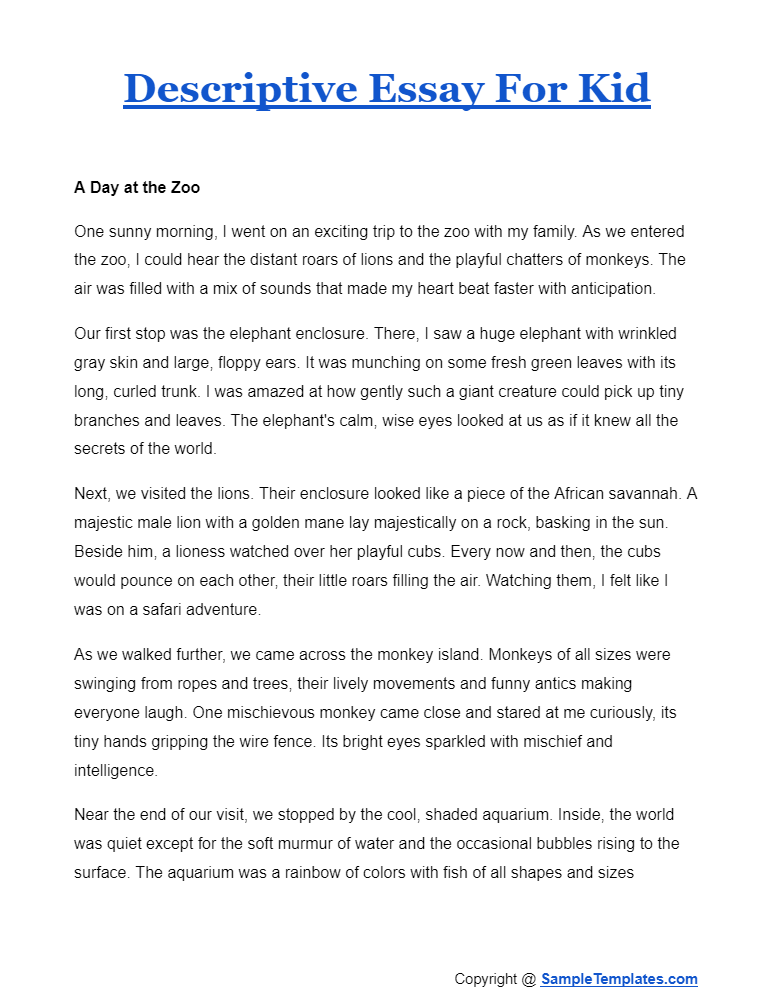
Browse More Templates On Descriptive Essay
Descriptive Narrative Essay Template
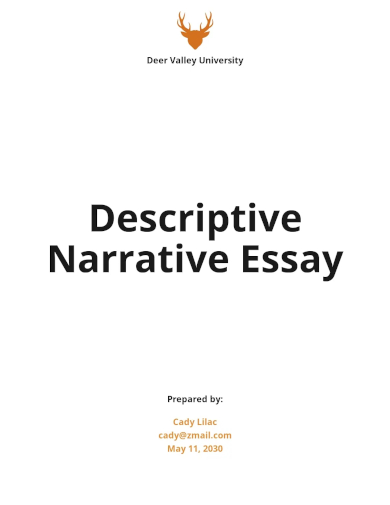
Personal Descriptive Essay Example
The personal descriptive essay is meant for readers to understand a person. The main thing to be careful about in personal descriptive essay is that there should not be any over-exaggeration. It can be used in such cases when a person has impacted your life. You may also see personal essays.
How to Write a Descriptive Essay?
Writing a descriptive essay involves vividly portraying a person, place, object, or event so that the reader can visualize and experience it themselves. Here’s a step-by-step guide on how to craft an effective descriptive essay:
1. Choose Your Topic
Select a topic that you are passionate about and can describe in detail. It could be a personal memory, a favorite place, an object that means a lot to you, or an unforgettable experience.
2. Gather Information and Ideas
Before you start writing, think about the sensory details of your topic. What do you see, hear, smell, taste, and touch? Make notes of these sensory experiences to use in your essay to help bring your description to life.
3. Create an Outline
Structure your essay in a way that guides the reader through your description. An outline might look like this:
- Introduction: Introduce the main topic of your essay and provide a hook to engage the reader.
- Body Paragraphs:
- Paragraph 1: Describe the most striking features or the initial impression of the subject.
- Paragraph 2: Go into more detail about the aspects you introduced in the first paragraph.
- Paragraph 3: Provide deeper insight and additional layers of detail.
- Conclusion: Summarize the main points of your essay and reflect on the significance of the topic or how it has impacted you.
4. Write the Introduction
Begin with a sentence that will catch the reader’s attention, known as the hook. Set the scene by providing context. End the introduction with a thesis statement that gives a brief overview of what your essay will cover.
5. Develop the Body Paragraphs
Each paragraph should focus on a specific aspect of your description, using vivid language and sensory details. Use metaphors, similes, and adjectives to enrich your text. Ensure that each paragraph flows smoothly into the next with transition words.
6. Conclude the Essay
The conclusion should tie back to your introductory thesis statement and summarize the main points of your essay. End with a final reflection on the topic, emphasizing its importance or the impression it has left on you.
7. Review and Revise
After writing your first draft, take a break before reviewing your work. Check for grammar and spelling errors, and make sure the essay flows well. Consider whether the sensory details are vivid and the descriptions are clear. Ask for feedback from peers or teachers to improve your essay.
8. Final Touches
Make final adjustments based on feedback and your own review. Ensure that your essay presents a coherent picture of the topic and engages the senses, allowing the reader to experience it as vividly as possible.
By following these steps, you can write a descriptive essay that offers readers a detailed, sensory experience of your chosen subject.
Sample Descriptive Narrative Essay Template
Descriptive Narrative Essay Example can be used mainly to recreate an event. This is mainly meant to say an incident that has happened to the writer. Although the component of the story is to narrate a story, all points should be backed up. You can also see the essay outline examples.
Types of Descriptive Essay
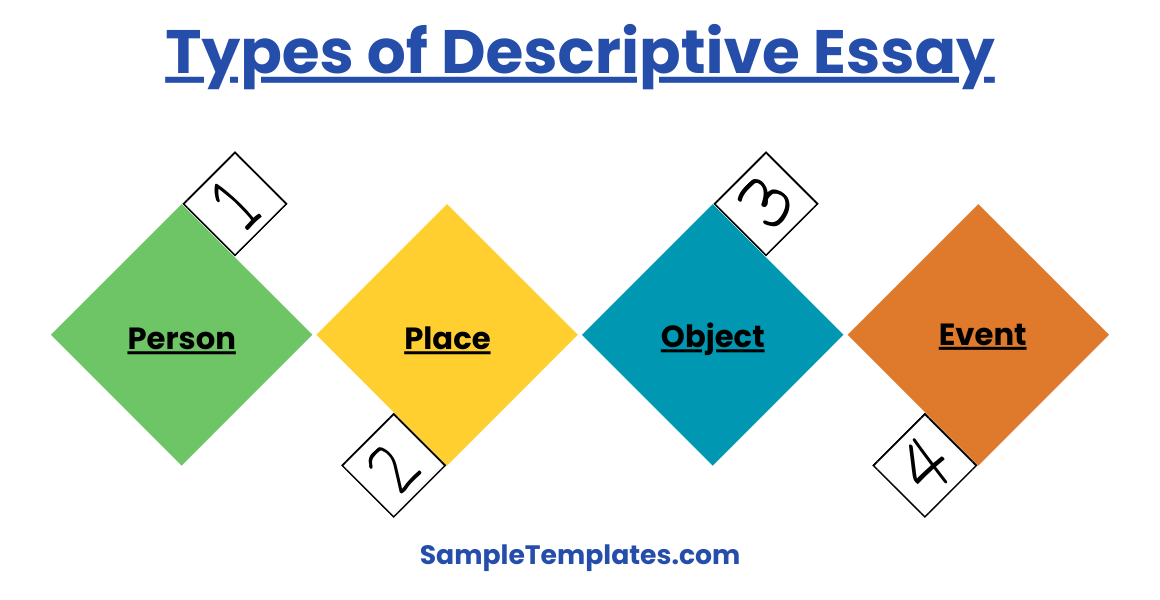
Descriptive essays come in various types, each tailored to evoke a unique and vivid picture of its subject. The main types of descriptive essays focus on describing different subjects such as people, places, objects, or events, each with a specific purpose and writing style. Here’s a breakdown of the most common types:
1. Person Description
This type of descriptive essay focuses on describing a person. It includes physical descriptions of the person’s appearance, but it goes deeper into capturing their character, emotions, and the impact they have on the writer or others. This can include descriptions of their behaviors, the sound of their voice, and even their mannerisms. This essay aims to make the reader feel as though they know the person personally.
2. Place Description
These essays describe a place in such a way that the reader can visualize it vividly. This could be a natural place like a forest or a beach, or a built environment like a house or a city. The description can include sensory details of what one sees, hears, smells, and feels in that place. The purpose is often to convey a particular mood or atmosphere that the place evokes.
3. Object Description
Descriptive essays about objects focus on something tangible — anything from a daily tool to an heirloom. These essays go beyond just the physical appearance of the object, delving into its texture, the way it feels to touch, its significance, and what it represents to the writer. Such essays may describe the object’s role in a larger narrative or its emotional resonance.
4. Event Description
This type describes a specific event, either past or ongoing. The writer recounts the event in detail, focusing on their personal experiences and sensory details to immerse the reader fully. This could include a description of actions, behaviors, and the environment during the event. It’s often used to convey the significance of the event and its impact on the writer.
5. Memory Description
Memory descriptions explore a personal memory of the writer, detailing a past experience that holds significant emotional value. This type of essay uses vivid descriptions to recreate the scene and evoke the same feelings and sensations that the writer experienced. The goal is to share the personal significance of the memory with the reader.
6. Process Description
Although less common, this type involves describing a process in a detailed, step-by-step manner. The description focuses on explaining how something happens or how to do something, often integrating sensory details to help the reader visualize the process clearly.
7. Comparative Description
This essay type involves comparing two or more entities, highlighting their similarities and differences through detailed descriptions. This could involve comparing places, people, objects, or other subjects, with an emphasis on descriptive detail to highlight unique qualities and nuances.
Each type of descriptive essay offers unique challenges and opportunities to explore different subjects in depth, using sensory details to bring the subject to life for the reader. The choice of which type of essay to write depends on the subject matter and the purpose of the essay.
Descriptive Essay on Market Template
Descriptive Essay on Market can be used by tourists or visitors that have no prior knowledge of a market. They can be used in order to describe the items that you get in the market. You may also see interview essay examples.
Who is the Target Audience for the Descriptive Essay Examples?
The descriptive essay examples can be on any principle and used by a broad range of people. For people who cannot personally experience something, descriptive essays provide a means to them to actually feel that by reading. For a reader who reads a descriptive essay before actually experiencing it can have a better picture of what is going to happen.You may also see literary essay examples.
It can be used by tourists as they will be uncommon with the practices in some place, office or a market. If there is confusion on what food to have, these descriptive essays describe exactly an item would taste. The reader can mentally taste the food without actually tasting it. You can also see the argumentative essay examples.
Descriptive Essay about Office Format
Templates like Descriptive Essay about Office can be useful for a person who is planning to visit an office. It can describe how an office works and the procedures. The whole process of going to the office should be described.You may also see narrative essays.
What Should a Descriptive Essay Include?
A descriptive essay should include several key elements to effectively convey the subject matter to the reader in a vivid and engaging manner. Here’s what it should include:
1. Engaging Introduction
- Hook: Start with a sentence that grabs the reader’s attention. This could be a striking fact, a question, or a bold statement related to the topic.
- Context: Provide some background information that helps the reader understand the subject or setting of the essay.
- Thesis Statement: Clearly state the focus of your description. This statement sets the tone for the essay and informs the reader about what they are about to experience.
2. Vivid Sensory Details
- Sight, Sound, Smell, Touch, Taste: Use sensory details to paint a picture of the scenes, events, people, or objects you are describing. The more specific your description, the more real it becomes for the reader.
- Show, Don’t Tell: Instead of simply telling the reader about the subject, show it through detailed observations, comparisons, and descriptions that evoke the senses.
3. Clear and Concise Language
- Adjectives and Adverbs: Use these to enhance the description but avoid overloading the essay with too many. Choose those that add real insight into the subject.
- Figurative Language: Metaphors, similes, and personification can add depth and creativity to your description, making abstract concepts more tangible and familiar.
4. Organized Structure
- Logical Progression: Organize the body paragraphs logically—either spatially, chronologically, or by importance—to guide the reader clearly through your description.
- Paragraph Unity: Each paragraph should focus on a single aspect of the description to keep the essay well-organized and coherent.
5. Purposeful Conclusion
- Summary: Recap the key impressions and details that were significant in the body of your essay.
- Reflection: Reflect on the broader significance of the subject. Discuss what it means to you, why it is important, or how it affects the reader.
6. Emotional Connection
- Engage Emotions: Aim to connect emotionally with the reader by conveying your feelings and attitudes towards the subject. This personal touch can make the description more compelling and memorable.
7. Review and Edit
- Clarity and Precision: Make sure that your essay is clear and precise. Remove any unnecessary words or details that do not contribute to the main description or confuse the reader.
- Consistency and Flow: Check for consistency in tone and style, and ensure that the text flows smoothly from one paragraph to the next.
Incorporating these elements will help make your descriptive essay clear, engaging, and memorable, allowing the reader to see, feel, and understand the essence of what you are describing.
Printable Introduction of a Descriptive Essay Example
As the whole idea of a descriptive essay is to provide a mental picture of someone, something or a place Introduction of a Descriptive Essay should give a briefing of that picture. The reader should get the idea of the whole essay from the introduction. You may also see self-assessment essay
What is the Purpose of a Descriptive Essay?

The purpose of a descriptive essay is to paint a vivid picture of a person, place, thing, or event, using detailed sensory observations. Its primary goal is to reveal the meaning of a subject through detailed, sensory observation, with the following specific objectives:
1. Engage the Reader’s Senses
A descriptive essay uses vivid language that engages the reader’s senses of sight, hearing, smell, taste, and touch. By doing so, it helps the reader visualize the scene or object described in a way that they feel they are experiencing it firsthand.
2. Create a Vivid Picture
The main aim is to create a vivid image in the reader’s mind. Through the use of detailed descriptions and expressive language, the essay paints a picture that is almost tangible. This not only makes the writing interesting but also helps the reader understand the essence of the subject.
3. Communicate a Deeper Meaning
Beyond just providing a physical description, descriptive essays often aim to convey a deeper meaning through the described imagery. This might involve expressing the emotions attached to the subject, explaining its significance, or offering a personal interpretation that adds a layer of depth to the description.
4. Evoke Emotion
Descriptive essays often aim to evoke emotions from the reader. By carefully choosing words and crafting scenes, the writer can guide the reader to feel specific emotions associated with the narrative. This emotional connection can make the subject more memorable and impactful.
5. Enhance Writing Skills
For the writer, crafting a descriptive the essay is an excellent exercise in honing writing skills. It encourages the use of imaginative language, development of narrative techniques, and the effective use of detailed observations, which are crucial skills in any form of writing.
6. Inform and Educate
In some cases, descriptive essays serve to inform or educate the reader about an unfamiliar subject by offering detailed descriptions that clarify the features or characteristics of the subject matter.
Overall, the purpose of a descriptive essay is to enrich the reader’s understanding and appreciation of the subject through the power of vivid and precise writing. It allows the reader to see the world through the writer’s eyes, deepening their understanding of both the subject and the writer’s perspective.
Descriptive Essay about a Person in PDF
What are the Benefits of Descriptive Essay Examples?
There is an illusion of reality as the description will have proofs bringing the reader to your fictional dream. It not only engages the reader intellectually but also emotionally. If the details are chosen correctly, the writer’s character can be expressed quickly. It can change the tension of the story by speeding it up or slowing it down. The situation literally comes alive for the reader as the reader reads through the essay. You can also see persuasive essay examples.
Unlike other objective essays it not only provides the big picture but also provides the inside details of the situation. It clearly conveys the point of view of the writer. They give the right intentions of the writer.
These descriptive essay examples use language to convey all five senses and emotions. personal essay examples will convey why a person appeals to you in life. The physical appearance and character traits can be described using descriptive essays. The writer should make sure that the reader understands the conclusions made in the essay.
What are the 3 features of descriptive essay?
- Sensory Details: Incorporates sights, sounds, smells, textures, and tastes to paint a vivid picture.
- Vivid Language: Uses metaphors, similes, and adjectives to enhance the description.
- Focused Description: Concentrates on a specific subject to provide an in-depth portrayal.
How to start a descriptive essay?
Begin with a hook that grabs the reader’s attention, such as an intriguing fact, a question, or a compelling description. Set the scene by providing context and introduce the main subject that will be described in detail.
How do I end a descriptive essay?
Conclude by summarizing the main points of your description and reflecting on the significance of the subject. Reinforce the emotional or sensory impact of the essay to leave a lasting impression on the reader.
What is the first paragraph of an essay called?
The first paragraph of an essay is called the introduction. It sets the stage for the entire essay, introduces the topic, and includes a thesis statement that outlines the main points or argument of the essay.
If you have any DMCA issues on this post, please contact us.
Related Posts
FREE 10+ Essay Introduction Samples in PDF
FREE 6+ Essay Organizer Samples in PDF | MS Word | Google Docs
FREE 10+ 5 Paragraph Essay Samples in PDF | MS Word | Apple Pages
FREE 10+ Argument Essay Samples in MS Word | Google Docs | PDF
FREE 10+ Research Essay Outline Samples in PDF | MS Word | Apple Pages
FREE 10+ Templates for Persuasive Essay Samples in PDF
FREE 10+ Essay Conclusion Samples in PDF
FREE 4+ MLA Format Essay Samples in PDF
FREE 10+ Leadership Essay Samples in MS Word | PDF
FREE 10+ Narrative Essay Outline Samples in PDF | MS Word | Google Docs
FREE 10+ APA Essay Samples in MS Word | Google Docs | PDF
FREE 10+ Research Paper Essay Samples in MS Word | Google Docs | PDF
FREE 8+ Sample Narrative Essay Templates in MS Word | PDF
FREE 10+ Community College Essay Samples [ Service, Builder, Transfer ]
FREE 10+ Admission Essay Samples [ College, Graduate, Nursing ]
